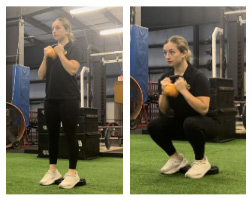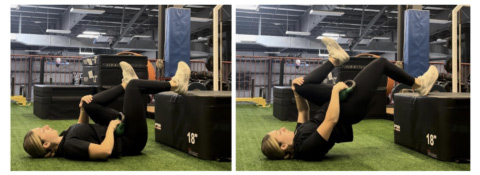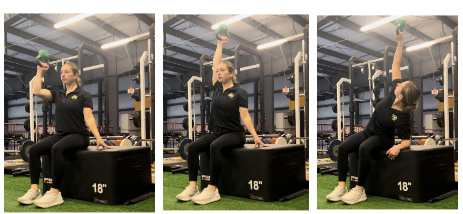5 Exercises Gymnasts Should Be Doing!
Let’s start with some gymnastics fun facts! Team USA men and women’s gymnastics collectively won 10 medals (3 hold, 1 silver, 6 bronze) at the Paris 2024 Olympics! What is even more impressive is that Simone Biles now has 11 Olympic medals (7 gold), making her the most decorated gymnast of all time. Simone Biles also has 5 skills named after her since she has been the first to perform these skills in a major international competition. While gymnastics culture is starting to shift for the better, gymnastics skills are becoming more difficult!
Why Strength Training?
The most successful gymnasts follow a consistent conditioning and training regimen! Gymnasts should not be fearful of lifting weights – in fact, gymnasts participating in both weight training and bodyweight exercises for conditioning are likely the ones on the podium at meets. Now, let’s be clear. Resistance training should NOT replace traditional gymnastics conditioning (rope climbs, bar hangs, handstands, etc.), but it should be incorporated for optimal performance and injury prevention. With sound programming and proper supervision for appropriate technique, strength programs that incorporate an external load (resistance bands, dumbbells, kettlebells, etc.) are one of the most effective methods for injury prevention.
Let me explain with some numbers…When a gymnast lands tumbling passes, the ground reaction forces throughout their lower body have been measured as high as 14.2-15x their body weight. Specifically, the ankle joint experiences upwards of 23x body weight and the hips 8.8-14.2x bodyweight upon impact. In addition, each dismount can result in 11.6-20x body weight in compressive force through the middle of the spine. It is evident that lower extremity strength and core strength are crucial for these athletes.
Not only do gymnasts have to tumble and dismount, but they also have to be able to swing on bars and flip over a vault. What is important to understand is that the wrists, elbows, and shoulders experience 2-4x body weight of force with each skill that is performed… even with something as “simple” as a round off! The upper extremities experience 1.5x body weight on vault, 3.1x body weight on uneven bars, and as high as 9.2x body weight for male gymnasts on the rings. After reading this, hopefully you understand the importance of upper body strength as well!
If body weight exercises and gymnastics-specific conditioning is the only type of training that a gymnast does on a consistent basis, then it is difficult to assume that their body is prepared for the demands of the sport. The exercises shown below are a great place to start and/or great exercises to add to your current program because they address full body strength and core stability.
The 5 Exercises
- Heels Elevated Goblet Squats – Squats are a fundamental exercise and are important as they strengthen your legs and load your spine! For this type of squat, you can place your heels on a small mat or weight to start and you will hold a weight in front of your chest.

- Weighted Cook Hip Lift – This exercise focuses on glute and hamstring strength. One heel will be on a box (or mat) and the other leg should be held close to your chest. Holding your opposite leg close to your chest minimizes possible compensations occurring through your low back. From this position, you will lift off of the ground and slowly lower back down.

- Chinese Plank Kicks – Set up two boxes (or mats) so that your shoulders are on one and your heels are on the other. While in this position, try not to let your hips sink down! From here, you will perform alternating leg kicks. When you are ready for an additional challenge, you can add ankle weights or hold a weight over your head. For the gymnasts reading this, it should look like you are in a hollow hold in between each repetition.

- Side Plank Shoulder External Rotation – Begin this exercise in a side plank position as shown below. Your elbow will be bent to 90 degrees while holding a dumbbell. The goal is to raise your forearm as your elbow stays by your side. This exercise prioritizes rotator cuff strength, shoulder stability, and core strength!

- Seated Press to Windmill – Hold the kettlebell in an upside down position and press overhead without letting the kettlebell tilt or tip over to challenge your wrist and shoulder stability and strength. While maintaining a straight elbow and a neutral wrist position, lean to the opposite elbow and rotate your arm so that your palm is facing away from you. It is important to perform this exercise slowly and controlled, with the goal of keeping your arm close to your ear throughout the descent. The gymnasts reading this blog will realize that this motion is similar to a pirouette on bars.

About the Author: Brielle Ciccio recently joined the Elite Foxboro team after earning her Doctorate of Physical Therapy from Duke University. She was also a competitive and accomplished gymnast for many years and loves sharing her expertise and experience in gymnastics with her patients.
At Elite Sports Performance & Physical Therapy, we specialize in sports and orthopedic physical therapy, sports performance training, and and youth and adult fitness training. If you or a friend or family member are in need of physical therapy following an injury or recent surgery or are looking to improve your sports performance or overall fitness, the expert team at Elite is here to help! Give us a call at 774-215-5401 (Foxboro) or 781-297-0979 (Stoughton) today to learn more today!
References
- Panzer, VP., Wood GA., Bates BT, et al. Lower extremity loads in landings of elite gymnasts. In G. de Grot, AP Hollander, PA Huijing, and GJ van Ingen Schenau (eds), Biomechanics XI-B (pp 727 – 735). Amsterdam, Netherlands: Free Univeristy Press.
- McNitt-Gray JL., Yokio T., Millward C. Landing strategy adjustment made by female gymnasts in response to drop height and mat composition. Journal of Applied Biomechanics.1993 9(3), 173-190
- Bruggemann GP. Mechanical load in artistic gymnastics and its relation to apparatus and performance. 1999. In M Leglise (ed), Symposium Medico-Technique (pp. 17-27). Lyss, Swizerland: International Gymnastis Fedearation.
- Caine D, Harringe ML. Epidemiology of injury in gymnastics. In Caine DJ., Russell K., Lim L. The Handbook of Sports Medicine: Gymnastics. 2013. Wiley-Blackwell: Oxford, pp 111 – 124
- Bruggermann DP Harringe ML. Biomechanics: injury mechanisms and risk factors. In Caine DJ., Russell K., Lim L. The Handbook of Sports Medicine: Gymnastics. 2013. Wiley-Blackwell: Oxford, pp 75 – 84
